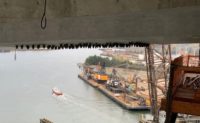In the early morning hours of Feb. 9, heavy rainfall and a high tide combined to knock off line Seattle’s 52-year-old West Point wastewater treatment plant. As the waterfront plant flooded and equipment failed, system operators routed up to 200 million gallons of combined runoff and effluent—90% stormwater and 10% wastewater—to an emergency bypass outfall, then into the Puget Sound.
West Point handles between 90 million to 300 million gallons a day during storm seasons. Weeks later, West Point was still at 50% capacity for primary treatment and providing no secondary treatment, even though that section of the plant wasn’t damaged. Instead, operators were diverting flows to the plant’s deepwater outfall three-quarters of a mile offshore, on the bottom of the Puget Sound.
“Right now, they are in recovery mode,” says Jeanne Kohl-Welles, King County council member and chair of the regional water-quality committee. “It’s a mess, to put it mildly.”
Following the failure, Mark Isaacson, director of King County’s wastewater treatment division, diverted flows to the Brightwater Treatment Plant in Woodinville and the South Plant in Renton.
During the storm, water backed up into the plant and the pump equipment failed, leading to flooding of the electrical system, an electrified water situation and, inside the plant’s tunnels, damage to doors unable to hold back 15 million gallons of surging water up to 15 ft deep.
National Response Corp. crews continue to sanitize flooded portions, even as 123 motors and pumps were identified as in need of repair or replacement. “The electrical systems are, by far, our biggest challenge and the critical path to getting back on line,” Isaacson says. The entire system of electrical panels, motor-control centers and power distribution systems must be replaced; further, even the conduits holding 1,000 miles of electrical wires must be manually dewatered, he added.
CH2M Hill is working on the design and replacement of the building’s electrical infrastructure and entered into a forensic analysis, which will include the event sequencing of what caused the apparent power failure.
Without a timetable yet in place, the first phase aims to get hydraulic and treatment capacity back on line with temporary systems; the longer-term solution will replace the temporary equipment.
“It was a total system breakdown,” Kohl-Welles says. “This shouldn’t have happened, even with the high tides.”
King County officials believe a $250-million FM Global insurance policy will cover the costs of the fix.
Due to the tide patterns and its location, West Point, which opened in 1965, has served as a sewer outfall point since 1904. The plant in 1995 received a $578-million upgrade, designed by CH2M Hill to provide secondary treatment.
As changing climate risks lead to violent weather events, wastewater plants must create new resiliency plans, says Martha Knowlton, Brown and Caldwell vice president. Already, her team is working on a wastewater-resiliency plan for New York City and will add Portland, Ore., as a client this month.
“Agencies and utilities are beginning to take advantage of technology, like a ‘smart utility’ framework, to make better decisions on operating their systems during unprecedented weather events,” Knowlton says.
Upgraded systems can merge data to measure an incoming storm, letting the system “know when to divert water or turn on ancillary systems to accommodate high stormwater flow.” Stormwater flow data provides information before storms reach treatment facilities, allowing time to divert flows.






